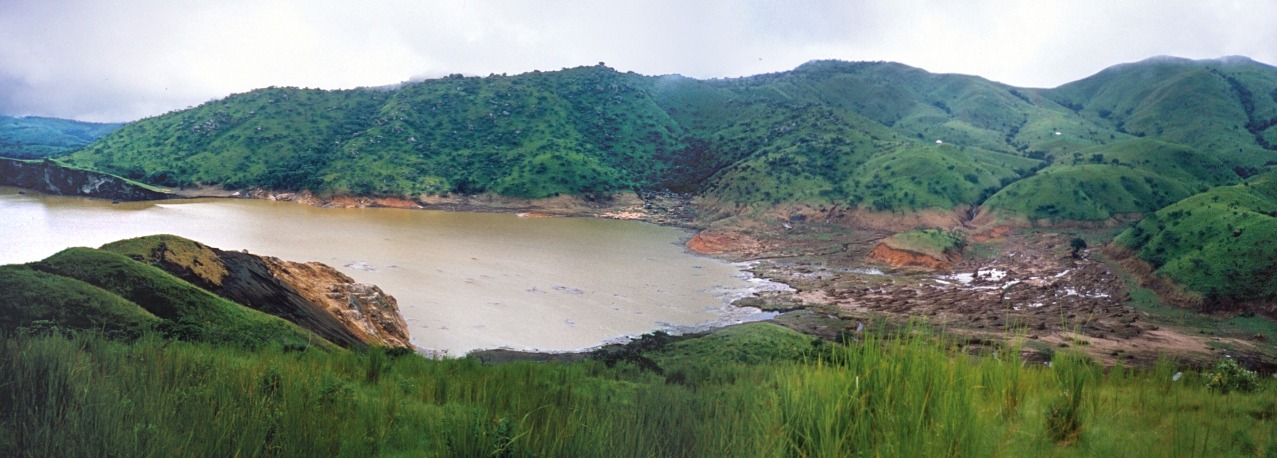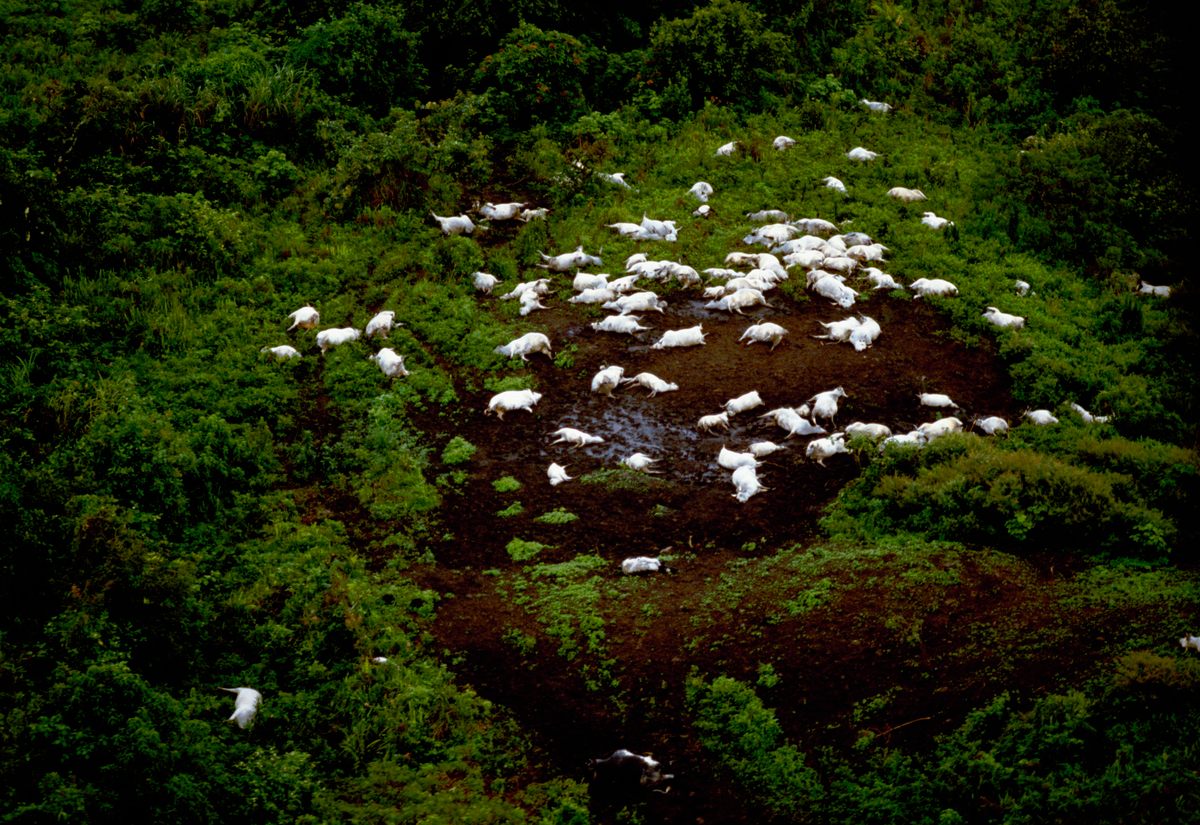In the heart of Cameroon, nestled in the volcanic region of the Northwest, lies a lake that would become infamous for one of the most terrifying and deadly natural disasters of the 20th century. On August 21, 1986, Lake Nyos erupted in what is known as a limnic eruption, a rare and catastrophic event that claimed the lives of over 1,700 people and left behind an eerie, lifeless landscape. The Lake Nyos disaster, though largely forgotten by the global community, remains a chilling reminder of the unpredictable and devastating power of nature.
What is a Limnic Eruption?
A limnic eruption, also called a lake overturn, is a rare natural phenomenon that occurs when large amounts of gas, primarily carbon dioxide (CO2), are suddenly released from the depths of a lake. This gas buildup occurs when volcanic activity beneath the lake causes a slow accumulation of CO2 in the water, often trapped by the weight of the water above it. The eruption happens when the pressure of the gas becomes too great, causing it to rapidly escape in a violent outburst.
Unlike other types of volcanic eruptions, a limnic eruption doesn’t involve molten lava or explosive ash clouds. Instead, the disaster is caused by the sudden release of dissolved gases that have been building up over many years, often with little warning. These eruptions can create deadly clouds of gas that can asphyxiate and suffocate anyone in its path.

The Calm Before the Storm: Lake Nyos
Lake Nyos, situated in the Western High Plateau of Cameroon, is a deep, crater lake formed by volcanic activity thousands of years ago. At over 200 meters deep, it is perched on the edge of an ancient caldera formed by volcanic forces. The lake, surrounded by lush hills and dense forests, appeared serene and peaceful—unaware of the deadly peril brewing beneath its surface.
In the years leading up to the disaster, scientists noticed signs that something was amiss with Lake Nyos. The water’s high CO2 concentration was slowly increasing due to volcanic activity beneath the lakebed. Despite this, the region remained largely unprepared for the catastrophe that would soon unfold.
The Day of the Disaster: August 21, 1986
On the evening of August 21, 1986, disaster struck with little warning. In a single, terrifying instant, the tranquil waters of Lake Nyos violently released a massive cloud of carbon dioxide that poured down the surrounding slopes and into nearby villages.
The eruption occurred at approximately 9:00 PM, when a sudden shift in the lake’s gas pressure caused the CO2 to explode out of the water. The gas cloud, dense and heavy, flowed downhill and into the valleys where people lived. The CO2 cloud, being odorless, colorless, and heavier than air, crept into the low-lying areas, suffocating everything in its path.
1,746 people were killed within hours, mostly from suffocation. Entire villages were wiped out as the gas infiltrated homes, farms, and fields. In addition to the human toll, thousands of livestock perished, and the land was left eerily silent. The villagers, who had been living in peace, had no way of anticipating the disaster, and many were asleep when the gas cloud swept through, making escape nearly impossible.

The Aftermath: Destruction and Mystery
When the eruption was over, the surrounding area looked like a war zone. Survivors, though few in number, described waking up to find their loved ones and animals dead. The once-thriving villages around Lake Nyos were left abandoned, and a strange, unnatural silence hung in the air. The region remained eerily quiet for days, with many bodies never being recovered due to the hazardous environment created by the gas cloud.
In the immediate aftermath, it was difficult to understand the full scale of the disaster. The official cause of the deaths was identified as asphyxiation due to carbon dioxide poisoning, but the precise mechanics of the eruption were not fully understood until later research uncovered the details of the limnic eruption. The gas cloud that had caused the deaths was not composed of typical volcanic gasses like sulfur dioxide or hydrogen sulfide, but rather, an incredibly concentrated mix of carbon dioxide.
Scientists soon realized that a combination of geological factors—volcanic activity, deep-water pressure, and a lack of natural venting—had created a lethal recipe. It was clear that Lake Nyos was not just a picturesque crater lake, but a ticking time bomb, ready to unleash its deadly contents.
Global Response and Preventive Measures
In the wake of the disaster, international attention was drawn to the need for better monitoring of limnic eruptions, particularly in regions with similar conditions. The tragedy at Lake Nyos prompted scientists to study the phenomenon more thoroughly in an effort to prevent similar disasters in the future.
One of the most immediate responses was the installation of degassing pipes in the lake. These pipes, designed to vent the dangerous carbon dioxide gas in a controlled manner, were inserted into the lake to slowly release the accumulated gas and reduce the risk of another catastrophic eruption. The project, which took years to complete, aimed to prevent future buildup of CO2 and ensure that Lake Nyos would not pose the same threat to surrounding communities.
Additionally, the Cameroon government, in collaboration with international agencies, relocated thousands of people living near the lake to safer areas. The project not only helped to address the risk of another eruption but also supported the rebuilding of the devastated communities. However, many of the survivors continued to live with the trauma and loss caused by the sudden, unexpected disaster.
The Lingering Legacy of Lake Nyos
The Lake Nyos disaster serves as a stark reminder of the power and unpredictability of natural phenomena. It’s a chilling example of how something as seemingly serene as a lake can turn into a deadly force in an instant. The eruption not only claimed lives but also shattered communities and left behind a lasting psychological impact on those who witnessed or survived the event.
Even today, Lake Nyos remains a source of both fascination and fear. It is no longer the tranquil, picturesque location it once was instead; it is a cautionary symbol of the power of nature’s hidden dangers. Though the risk of another eruption has been greatly reduced, the memory of the disaster is still fresh for many, and the lessons learned from this horrific event continue to shape how we understand and prepare for limnic eruptions worldwide.
A Deadly Reminder of Nature’s Hidden Forces
The Lake Nyos disaster is one of the most terrifying and tragic examples of a limnic eruption in modern history. It stands as a reminder of how vulnerable human populations can be to the power of nature, especially when that power is hidden beneath the surface. While advancements in science and technology have provided some protection for the region, the haunting memory of that fateful night in 1986 will never be forgotten.
As we continue to study and monitor our environment, it’s crucial to remain aware of the unpredictable forces that lie beneath our feet—and above our heads. The story of Lake Nyos reminds us that nature’s most catastrophic events can occur when we least expect them, and that preparation, understanding, and respect for our environment are the best tools we have to protect ourselves from its wrath.


